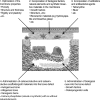Barrier membranes: More than the barrier effect?
- PMID: 30667525
- PMCID: PMC6704362
- DOI: 10.1111/jcpe.13068
Barrier membranes: More than the barrier effect?
Abstract
Aim: To review the knowledge on the mechanisms controlling membrane-host interactions in guided bone regeneration (GBR) and investigate the possible role of GBR membranes as bioactive compartments in addition to their established role as barriers.
Materials and methods: A narrative review was utilized based on in vitro, in vivo and available clinical studies on the cellular and molecular mechanisms underlying GBR and the possible bioactive role of membranes.
Results: Emerging data demonstrate that the membrane contributes bioactively to the regeneration of underlying defects. The cellular and molecular activities in the membrane are intimately linked to the promoted bone regeneration in the underlying defect. Along with the native bioactivity of GBR membranes, incorporating growth factors and cells in membranes or with graft materials may augment the regenerative processes in underlying defects.
Conclusion: In parallel with its barrier function, the membrane plays an active role in hosting and modulating the molecular activities of the membrane-associated cells during GBR. The biological events in the membrane are linked to the bone regenerative and remodelling processes in the underlying defect. Furthermore, the bone-promoting environments in the two compartments can likely be boosted by strategies targeting both material aspects of the membrane and host tissue responses.
© 2019 John Wiley & Sons A/S. Published by John Wiley & Sons Ltd.
Conflict of interest statement
Omar Omar received grants from Osteology Foundation , grants from Hjalmar Svensson Foundation, during the conduct of the study. Ibrahim Elgali received a grant from Hjalmar Svensson Foundation, during the conduct of the study.Peter Thomsen received grants from Swedish Research Council , grants from ALF/LUA Research Grant , grants from IngaBritt and Arne Lundberg Foundation, grants from Vilhelm and Martina Lundgren Vetenskapsfond , grants from Area of Advance Materials of Chalmers and GU Biomaterials within the Strategic Research Area initiative launched by the Swedish Government, during the conduct of the study. Christer Dahlin received a grant from Osteology Foundation, during the conduct of the study.
Figures




References
-
- Aghaloo, T. L. , & Moy, P. K. (2007). Which hard tissue augmentation techniques are the most successful in furnishing bony support for implant placement? International Journal of Oral & Maxillofacial Implants, 22(Suppl), 49–70. - PubMed
-
- Al‐Hezaimi, K. , Rudek, I. , Al‐Hamdan, K. S. , Javed, F. , Nooh, N. , & Wang, H. L. (2013). Efficacy of using a dual layer of membrane (dPTFE placed over collagen) for ridge preservation in fresh extraction sites: A micro‐computed tomographic study in dogs. Clinical Oral Implants Research, 24, 1152–1157. 10.1111/j.1600-0501.2012.02526.x - DOI - PubMed
-
- Amar, S. , Chung, K. M. , Nam, S. H. , Karatzas, S. , Myokai, F. , & Van Dyke, T. E. (1997). Markers of bone and cementum formation accumulate in tissues regenerated in periodontal defects treated with expanded polytetrafluoroethylene membranes. Journal of Periodontal Research, 32, 148–158. 10.1111/j.1600-0765.1997.tb01397.x - DOI - PubMed
Publication types
MeSH terms
Substances
LinkOut - more resources
Full Text Sources

